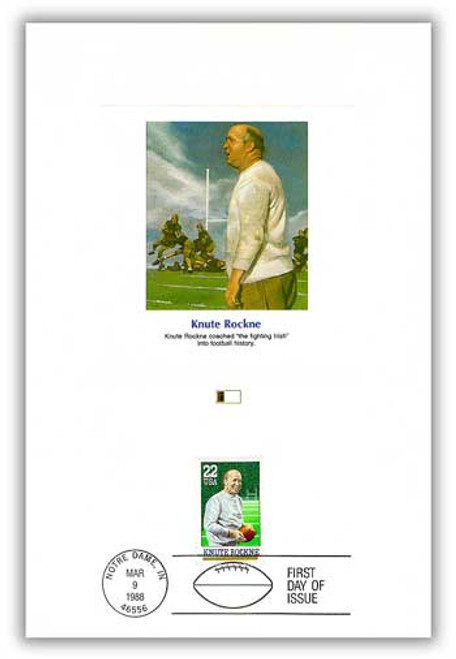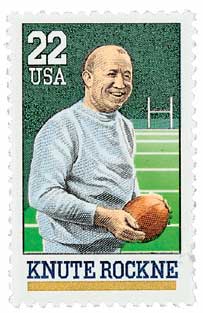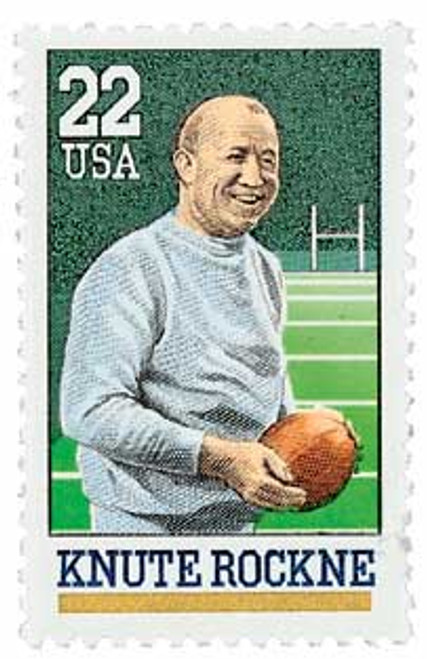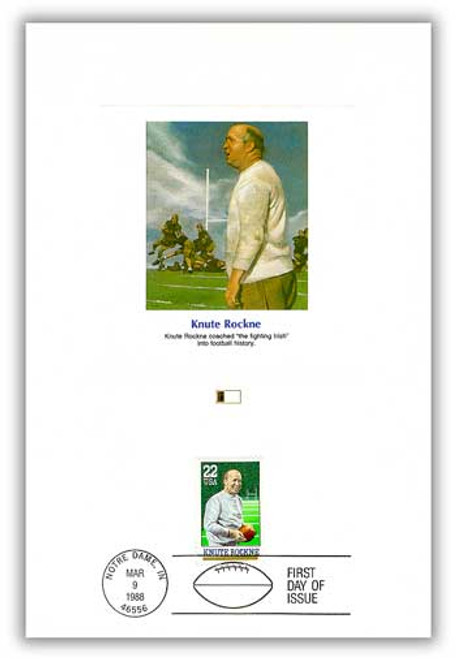
# 55646 FDC - 1988 Knute Rockne Proofcard
Often called the ultimate philatelic issue, the Fleetwood Proofcard is a distinctive commemorative with an elegantly embossed surface. Each Proofcard bears an original work of art complementing the theme of the stamp and created exclusively for Fleetwood by a leading American artist. Proofcards are often collected on their own, but would also make a beautiful addition to your existing stamp or cover collection.
Happy Birthday Knute Rockne
Rockne’s family moved to Chicago when he was five and he spent his childhood in the Logan Square section of the city. It was here he first learned to play football and eventually played end for the Logan Square Tigers. In high school, Rockne played football and ran track.
After high school, Rockne spent four years working as a mail dispatcher for the Chicago Post Office. Once he saved enough money, he went to Notre Dame to study chemistry. While there he continued to play end and won All-American honors in 1913.
On November 1 of that year Rockne also played an important game that would change the way college football was played. Facing off against West Point, Notre Dame’s quarterback threw accurate downfield passes to Rockne to help win the game 35 to 13. While it wasn’t the invention of the forward pass, it was the first significant game in which the pass was effectively used several times.

Rockne graduated from Notre Dame in 1914 with a degree in pharmacy. He briefly worked as a lab assistant until he got the chance to play professional football. He began his career with the Akron Indians playing both end and halfback. Then in 1915 he went to play with the Massillon Tigers, where he helped make the forward pass part of professional football.
In 1918, Rockne took over as coach of the Notre Dame “Fighting Irish” football team. Over the next 13 years, his team won 105 games, lost only 12, and tied 5, giving him a career winning percentage of .881 – the highest in college football history. Under his direction as head coach, the famous “Fighting Irish” saw five unbeaten, untied seasons.

Rockne was as brilliant off the field as he was on it. He recognized that college football could be a real moneymaker and worked hard to make money for the team and school. He charmed the media to get free advertising and even found success as a spokesman for a local Studebaker dealership, among other products.

Rockne also coached Notre Dame’s legendary Four Horsemen. Supported by the “Seven Mules” linemen, the Four Horsemen, quarterback Harry Stuhldreher, halfbacks Don Miller and Jim Crowley, and fullback Elmer Layden, lost only two of the 30 games they played from 1922-24. Their final victory was in the Rose Bowl – college football’s oldest and perhaps most prestigious bowl game.
Sportswriter Grantland Rice coined the name for a 1924 article. After Rice’s article was printed, publicity aide George Strickler came up with a photo to promote the players’ reputations as the “Four Horsemen.” The players were shown dressed in their football uniforms mounted on four horses from a local stable. This photograph was featured in newspapers across the country and helped to popularize their legendary status.
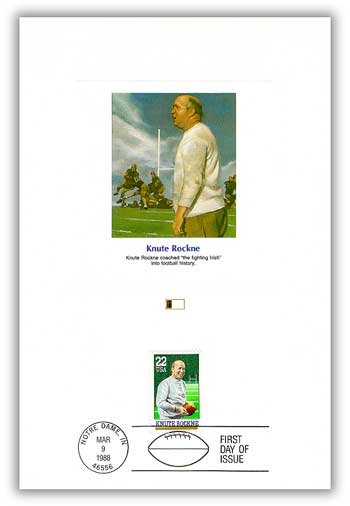
Then, in late March 1931, Rockne was on a trip to film The Spirit the Notre Dame. The wings of the plane he was flying on broke, leading it to crash in Kansas, killing Rockne and seven others. Rockne’s death became national news and President Herbert hoover called it “a national loss.” His death also led to a public inquiry and major changes to the aviation industry, turning it into one of the safest forms of travel.
Often called the ultimate philatelic issue, the Fleetwood Proofcard is a distinctive commemorative with an elegantly embossed surface. Each Proofcard bears an original work of art complementing the theme of the stamp and created exclusively for Fleetwood by a leading American artist. Proofcards are often collected on their own, but would also make a beautiful addition to your existing stamp or cover collection.
Happy Birthday Knute Rockne
Rockne’s family moved to Chicago when he was five and he spent his childhood in the Logan Square section of the city. It was here he first learned to play football and eventually played end for the Logan Square Tigers. In high school, Rockne played football and ran track.
After high school, Rockne spent four years working as a mail dispatcher for the Chicago Post Office. Once he saved enough money, he went to Notre Dame to study chemistry. While there he continued to play end and won All-American honors in 1913.
On November 1 of that year Rockne also played an important game that would change the way college football was played. Facing off against West Point, Notre Dame’s quarterback threw accurate downfield passes to Rockne to help win the game 35 to 13. While it wasn’t the invention of the forward pass, it was the first significant game in which the pass was effectively used several times.

Rockne graduated from Notre Dame in 1914 with a degree in pharmacy. He briefly worked as a lab assistant until he got the chance to play professional football. He began his career with the Akron Indians playing both end and halfback. Then in 1915 he went to play with the Massillon Tigers, where he helped make the forward pass part of professional football.
In 1918, Rockne took over as coach of the Notre Dame “Fighting Irish” football team. Over the next 13 years, his team won 105 games, lost only 12, and tied 5, giving him a career winning percentage of .881 – the highest in college football history. Under his direction as head coach, the famous “Fighting Irish” saw five unbeaten, untied seasons.

Rockne was as brilliant off the field as he was on it. He recognized that college football could be a real moneymaker and worked hard to make money for the team and school. He charmed the media to get free advertising and even found success as a spokesman for a local Studebaker dealership, among other products.

Rockne also coached Notre Dame’s legendary Four Horsemen. Supported by the “Seven Mules” linemen, the Four Horsemen, quarterback Harry Stuhldreher, halfbacks Don Miller and Jim Crowley, and fullback Elmer Layden, lost only two of the 30 games they played from 1922-24. Their final victory was in the Rose Bowl – college football’s oldest and perhaps most prestigious bowl game.
Sportswriter Grantland Rice coined the name for a 1924 article. After Rice’s article was printed, publicity aide George Strickler came up with a photo to promote the players’ reputations as the “Four Horsemen.” The players were shown dressed in their football uniforms mounted on four horses from a local stable. This photograph was featured in newspapers across the country and helped to popularize their legendary status.

Then, in late March 1931, Rockne was on a trip to film The Spirit the Notre Dame. The wings of the plane he was flying on broke, leading it to crash in Kansas, killing Rockne and seven others. Rockne’s death became national news and President Herbert hoover called it “a national loss.” His death also led to a public inquiry and major changes to the aviation industry, turning it into one of the safest forms of travel.

